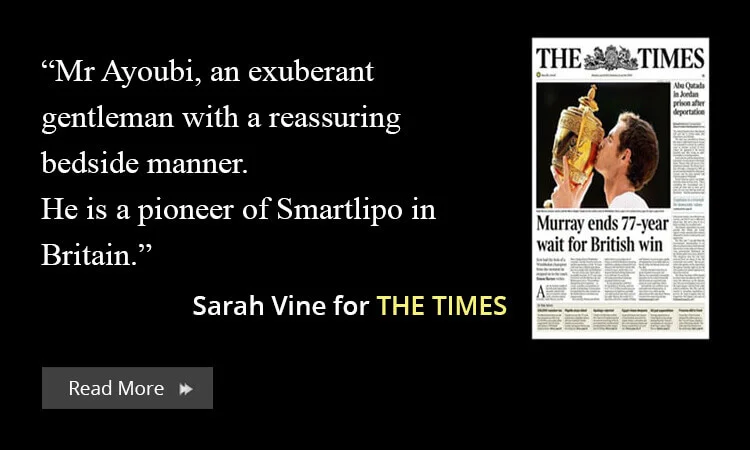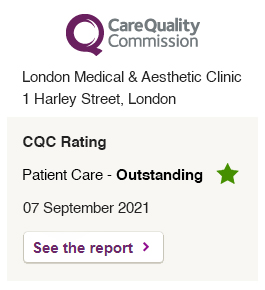Read more about Non-Surgical Rhinoplasty
The non-surgical rhinoplasty is a technique for remodelling and reshaping the nasal framework with the use of dermal filler injections.
Using a precise series of injections of the dermal filler, the surgeon can soften sharp angles of the nose, fill depressions and change the shape of the tip of the nose with instant and natural results.
The results are immediate and there is no recovery or down time as there are very rarely any bruising or swelling.
The non surgical nose job is a well proven, safe treatment that has become very popular and we have performed hundreds of these cases at our clinic.
This is the new, safe and non invasive alternative to nasal surgery (rhinoplasty). It involves the injection of dermal filler in key areas around the nose which can change the overall shape or result in a straighter nose.
The use of dermal fillers can change the appearance of your nose if you are unhappy about the shape, or have an unattractive bump, depression or asymmetry.
Also ideal if you have had an accident which has caused a deformity or have had nasal surgery and are not quite happy with the results
Who can benefit from Non-Surgical Rhinoplasty?
As the nose is the central feature of the face, it has a significant effect on facial aesthetics.
The nasal contours and the nasal tip strongly define the character of the nose which is the reason why surgical reduction or alteration of the tip is very popular.
Non-Surgical Rhinoplasty is a safe and non invasive alternative to nasal surgery (rhinoplasty). It involves the injection of dermal filler in key areas around the nose which can change the overall shape or result in a straighter nose.
The use of dermal fillers can change the appearance of your nose if you are unhappy about the shape, or have an unattractive bump, depression or asymmetry. Also ideal if you have had an accident which has caused a deformity or have had nasal surgery and are not quite happy with the results.
A non-surgical rhinoplasty is an ideal option for adult patients who perhaps have a contraindication for surgery or have previously had nasal surgery which needs correction.
Patients who are considering a surgical procedure and see this as a stepping stone towards how a ‘new nose’ might look, before they commit to going under the knife.
No-surgical nose job is not an option for all patients with the usual contraindications in place for those with acute chronic skin disease, pregnancy/ breastfeeding, allergies or intolerances to dermal filler materials being used.
Ideal Candidates for the Non-Surgical Nose Job Procedure are:
- People who wish to decrease the appearance of bumps on their nose
- People with a flat nasal bridge who wish to create a bridge or augment their original bridge
- People who have indentations or have asymmetric noses
- People who wish to raise the tip of the nose
- People who have had surgical nose jobs in the past and are unhappy with the result
- People who are considering having surgery and would like to see the potential result
What are the expectations of Non-Surgical Rhinoplasty?
A non-surgical rhinoplasty is an ideal option for adult patients who perhaps have a contraindication for surgery or have previously had nasal surgery which needs correction.
Patients who are considering a surgical procedure and see this as a stepping stone towards how a ‘new nose’ might look, before they commit to going under the knife.
No-surgical nose job is not an option for all patients with the usual contraindications in place for those with acute chronic skin disease, pregnancy/ breastfeeding, allergies or intolerances to dermal filler materials being used.
During the procedure topical anaesthesia will be applied to the nasal surface which will provide a very good numbing effect. The dermal filler which is also mixed with local anaesthetic is then injected onto precise areas of the nose. The procedure is painless and lasts around a few minutes only.
Following the procedure there may be very minimal swelling or redness which subsides in a few hours. Most people can resume their daily activities and work immediately.
A free follow up consultation is arranged one-two weeks later at our clinic.
Dr Ayham Al-Ayoubi, ENT, Facial Plastic Surgeon believes the concept of the non-surgical rhinoplasty started when surgeons who were performing traditional, surgical rhinoplasty procedures realised that when they were injecting the local anaesthetic into the nasal area they were getting a degree of correction from the simple addition of the lidocaine solution to the region; hence the seed of the idea for the use of injectables was planted.
When addressing the nose for non-surgical rhinoplasty treatment the facial plastic surgeon will assess anatomical structures of the face.
Dr Ayham Al-Ayoubi: it’s crucial to the surgeon to understand and know in extreme details all nasal structures before considering dermal filler injections which could be in some cases combined with Anti-Wrinkle Injections.
The nose is a complex area of movement in the face, which is no surprise given its primary role in allowing us to breathe.
The movements of the nose are affected by four key groups of muscles, the elevators (including the procerus), the depressors, the compressors and the dilators.
As a structure the nasal area is comprised of bone, cartilage and a composite of the two known as cartilaginous or osteo-cartilaginous structures.
The external anatomy includes the dorsum, the sidewalls, the lobule, the soft triangles, the alae and the columella. It’s worth noting that these are configured differently depending on the race or ethnic grouping of the patient. Internally, the septum is the osteo-cartilaginous structure that splits the nose into two halves which end in the left and right nostrils.
It’s important to have an understanding of the overlying skin and how it differs in thickness and adhesion to the underlying cartilaginous and bony structures in the upper, middle and lower nose.
The anatomical area of key importance when considering embarking on a non-surgical rhinoplasty is the vascular system which provides the blood supply to the nose.
Avoiding complications due to interference with the blood supply is the primary goal when injecting dermal fillers into the nasal area.
Sound advice to mitigate the risk and prevent simple errors would include always aspirating the needle prior to injecting product, a practice that all facial plastic surgeons should be familiar with as a matter of good sense, as well as gradual injection of the product and not over-filling.
It is equally important to have an artistic approach to any rhinoplasty procedure, whether surgical or non-surgical.
What are the possible side effects?
With most aesthetic procedures there is the potential for possible complications and non-surgical rhinoplasty is no exception.
It is the duty of the surgeon to minimise the possible rare side effects even though he can not eliminate them.
In capable hands, with the right training and experience, this is a very safe and effective procedure. Over time the technique has evolved to optimise the effects and reduce problems.
The rare side effects/ complications include: infection, hematoma, pain and discomfort, post-procedural asymmetries and foreign body reaction.
There are different groups of Dermal fillers. The most popular group is hyaluronic acid based, such as Anteis, Juvederm, Perectha, Dermal Fillers , STYLAGE and Teosyal.
The Hyaluroinc acid is a fluid which occurs naturally in the skin and which allows the skin to retain a plump, full appearance over time, and restore skin to a firmer and more youthful appearance.
The other group is Ellanse, which is the first dermal filler to offer a safe, unique, tunable longevity, specifically designed for the field of aesthetic medicine and surgery with the result lasting from two to four years.
Radiesse (calcium hydroxyl appetite crystals based) is another group and it well know for its safety and its ability to be incorporated into the superficial dermis and are absorbed gradually as time passes.
Aquamid ( Polyacrylamide based) is a unique soft-volume filler with immediate results and, unlike temporary fillers; these results will not disappear or fade over time. It is biocompatible and non-allergenic and its high water content makes the treated area look and feel soft in a natural way.
All above groups of dermal fillers are approved by MHRA in the UK and the FDA in USA.
Dr Ayham Al-Ayoubi has performed hundreds of non-surgical nose jobs at our clinic using different types of dermal fillers.
History of Non-Surgical Rhinoplasty
Rhinoplasty is the oldest known of the plastic surgery procedures, having been reported as a method for repairing broken noses in ancient Egyptian medical texts dated to 3,000 BC, as well as by the Ayurvedic physician Sushruta in ancient India circa 800 BC who wrote about reconstructing noses which had been amputated for religious or criminal punishment.
The development of the forehead flap rhinoplasty is attributed to Sushruta; this technique was also used in modern day plastic surgery on soldiers who returned from World War I with facial trauma and is still a technique used in current practice for severe cases.
Given its history, Rhinoplasty is probably one of the most written about and developed areas of facial surgery which has mostly remained unchanged in principle for several thousands of years; the aim remaining to correct nasal complications caused by trauma or birth defects.
In the modern era, the concept of a cosmetic rhinoplasty has evolved, with the surgery being less about a medical need to improve nasal function or correct a significant nasal deficit and more about a desire to improve on the look of the nose that god gave someone.
Although not as old as surgical rhinoplasty techniques, the non-surgical procedure is not as new as we might all think.
Dr Ayham Al-Ayoubi, ENT, Facial Plastic Surgeon believes the concept of the non-surgical rhinoplasty started when surgeons who were performing traditional, surgical rhinoplasty procedures realised that when they were injecting the local anaesthetic into the nasal area they were getting a degree of correction from the simple addition of the lidocaine solution to the region; hence the seed of the idea for the use of injectables was planted.
The first reported case of a non-surgical rhinoplasty is from the late 1800s, when an American neurologist James Leonard Corning and a Viennese physician Robert Gersuny used liquid paraffin wax to lift a saddle nose deformity (collapsed nasal dorsum), needless to say, the idea was great, but liquid paraffin was soon discovered to be harmful to the patient!
It took until the 1960s and 70s for surgeons to experiment again, this time with medical grade silicone gels, however again complications were noted, often several years post injection, including ulcers and granuloma formation.
Fast forward to the turn of the millennium and American Dr. Alexander Rivkin published his method for the non-surgical nose job or ‘injection rhinoplasty’ following a year’s experience injecting Dermal Fillers and Radiesse (calcium hydroxyl appetite crystals) in 2003.
The main observation attributed to Dr Rivkin, which is the primary confusion with how this technique works, is that he observed that straightening the nose actually made it appear smaller, even though he was augmenting the tissues with the filler, yet by making it all blend better with the contours of the rest of the face it achieved the aim that until then could only be done by surgery.
In 2009 Dr Rivkin published a study of 385 patients which remains the largest published experience with this injection rhinoplasty technique in the world.
Since then, many more surgeons around the globe have trained in and practiced the technique and more clinical are ongoing looking at the use of differing dermal filler products.
Dr Ayham Al-Ayoubi has performed hundreds of non-surgical nose jobs at our clinic using different types of dermal fillers.














































